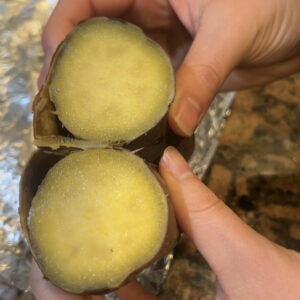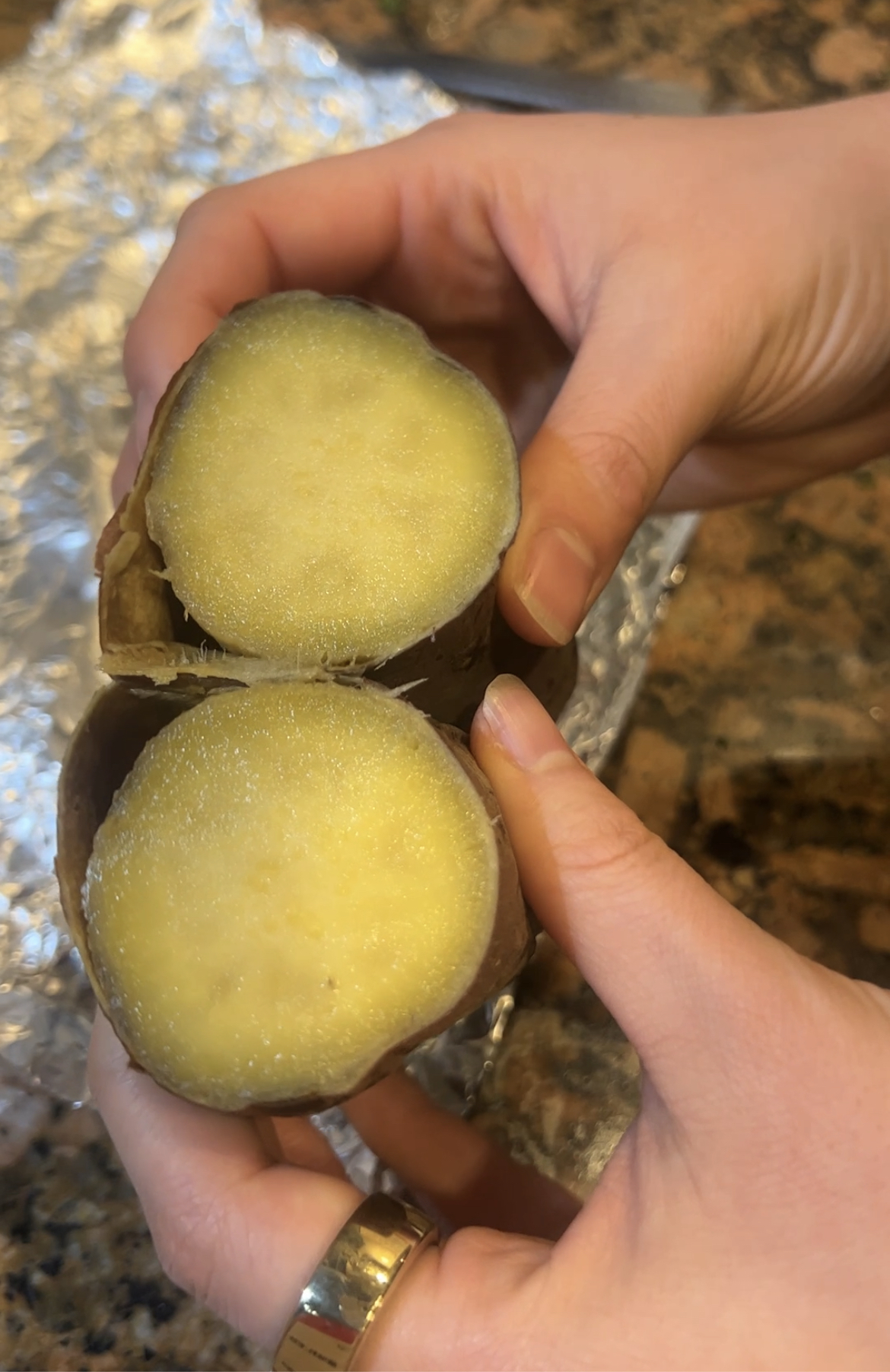
I guarantee that every single person in Japan can sing the yakiimo truck song if you ask them to! The smell of the slow roasted Japanese sweet potato + the song playing in the background = fall/winter in Japan!
YAKI means to cook/bake and IMO means potato!
When it starts to get colder in Japan, I find myself walking out with a yakiimo whenever I go buy anything at Don Quijote in Japan (the most overwhelming but incredible store that sells anything you could ever imagine lol). They have a machine in their entrance where you can smell them slow roasting the Japanese sweet potatoes over the hot stones and it’s DIVINE.
The full name of the sweet potatoes you can buy from the trucks in Japan or in the supermarkets is “ishi-yakiimo“. “Ishi” means stone because traditionally, they bake Japanese sweet potatoes on hot stones. The heat of the hot stones slowly cooks the sweet potatoes — the key is how long the sweet potatoes are held between the degrees of 65C – 80C.
Not all sweet potatoes are created equal! Here are two of the best varieties for making the creamiest, most flavorful Japanese-style roasted sweet potatoes:
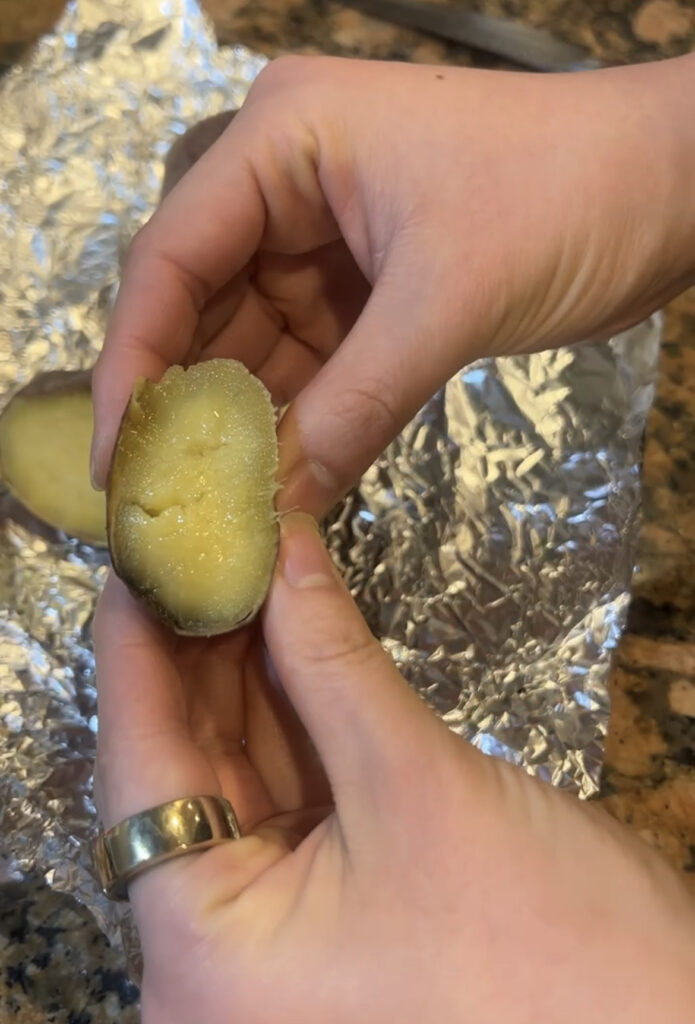
Baking Time Tip: If your sweet potatoes are larger, bake them for at least 90 minutes for the perfect texture.
Let me take a step back and explain the science behind why these sweet potatoes get SO sweet just by baking them!
Food enzymes are quite amazing. I am currently studying to get my food fermentation license and have been studying on food enzymes, especially in Japanese food. I learned about amylase which is an enzyme that is naturally in sweet potatoes. When you cook sweet potatoes, the amylase enzyme turns the starches into sugar which is why it’s so sweet!
You might find that depending on how you cook the sweet potatoes, you can get them to be even SWEETER!
Amylase is most active between 65°C–80°C (149°F–176°F), meaning that when sweet potatoes are cooked at this temperature, their starches convert into sugar, creating that signature caramelized sweetness.
This makes the sweet potato baking process SO much easier because all of you have to do is pop it into the oven and bake!
NOTE: Depending on the size of your sweet potatoes and the type of Japanese sweet potato, the silkiness of the potatoes will change! If your sweet potatoes are a little bit larger, you may need to bake them for 90 minutes.
✔ 2–3 Japanese sweet potatoes (Beni Haruka or Silk Sweet)
✔ Water (for soaking paper towels)
✔ Aluminum foil
1. Wash all of your sweet potatoes thoroughly (especially the ends where there may be dirt on it). I like to scrub with a brush to get all of the dirt off.
2. Without drying off the sweet potatoes (since it adds moisture) wrap the sweet potatoes in a paper towel and quickly run water over the paper towel again to make it wet. If it’s DRIPPING with water, I recommend lightly wringing it out just enough so that you don’t have a puddle of water.

3. Wrap the wet sweet potato and paper towel in a large piece of aluminum foil so that the sweet potato is completely covered.

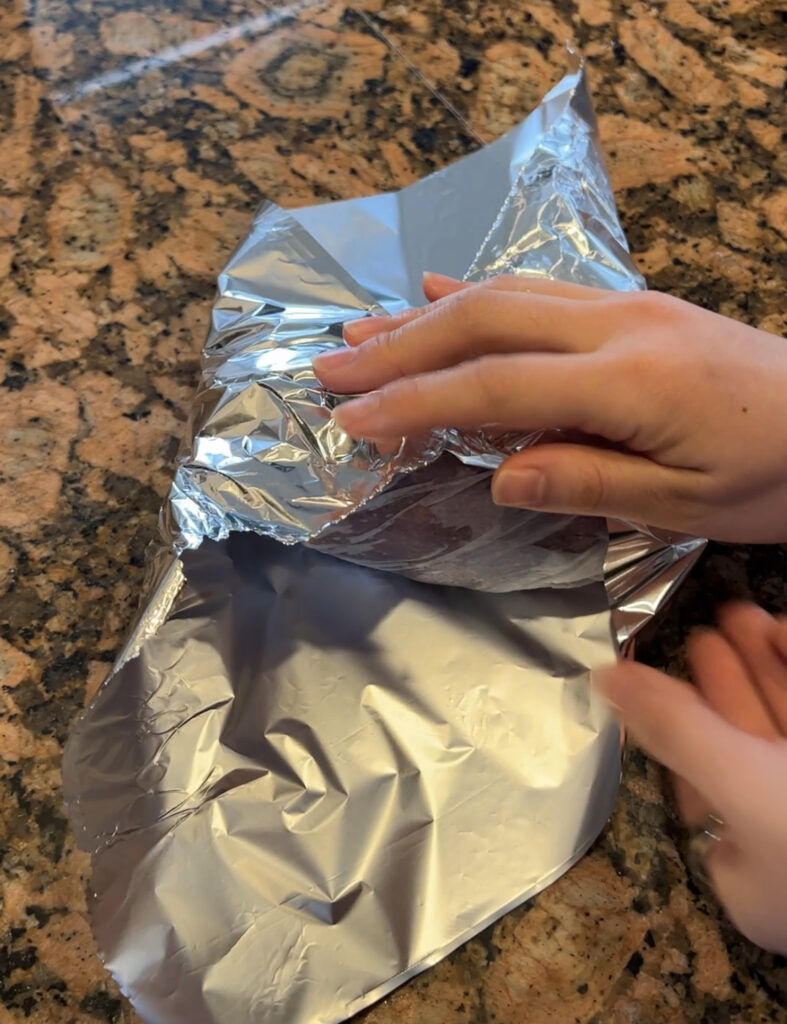
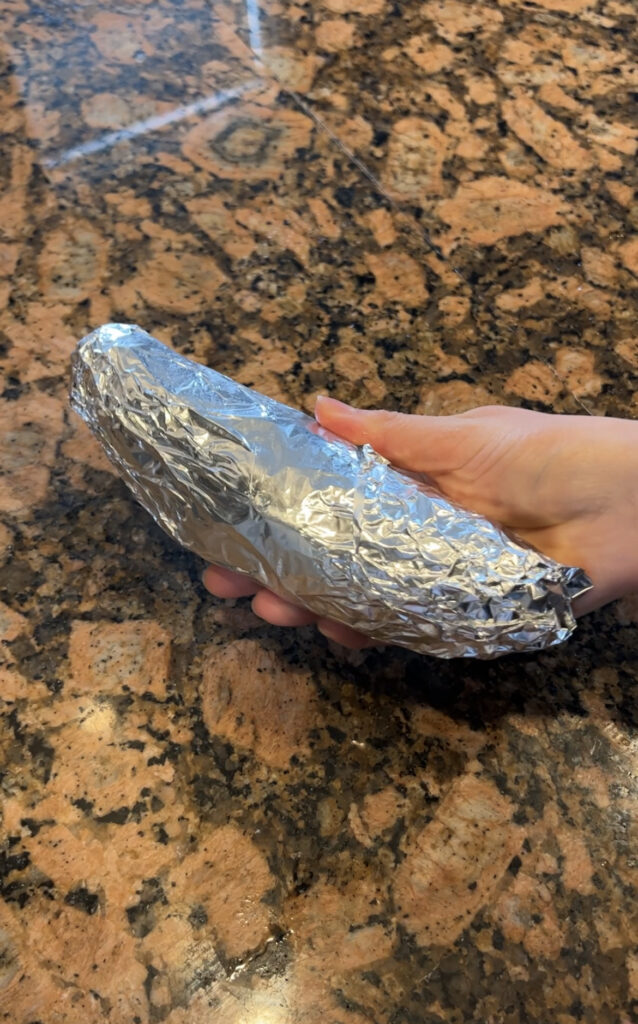
4. Place the Japanese sweet potatoes onto a baking dish and place it into your oven.
5. Turn on your oven and set it to 160C or 320F. While your oven heats up with the sweet potatoes inside, it will give your sweet potatoes a good enough time to stay in the 65C – 80C range and get them EXTRA sweet!
6. Once your oven has preheated, set your timer for 90 minutes.
7. After 90 minutes, leave your sweet potatoes in the oven for at least 30 minutes to let it cool down to the ideal range again. This step is crucial in ensuring you get a silky smooth baked Japanese sweet potato.
8. Once your Japanese sweet potatoes are cool enough to touch, you are ready to enjoy!
I love to eat them a little warm because they are already so sweet and creamy, but you can also add a little butter and cinnamon for an extra cozy bite!
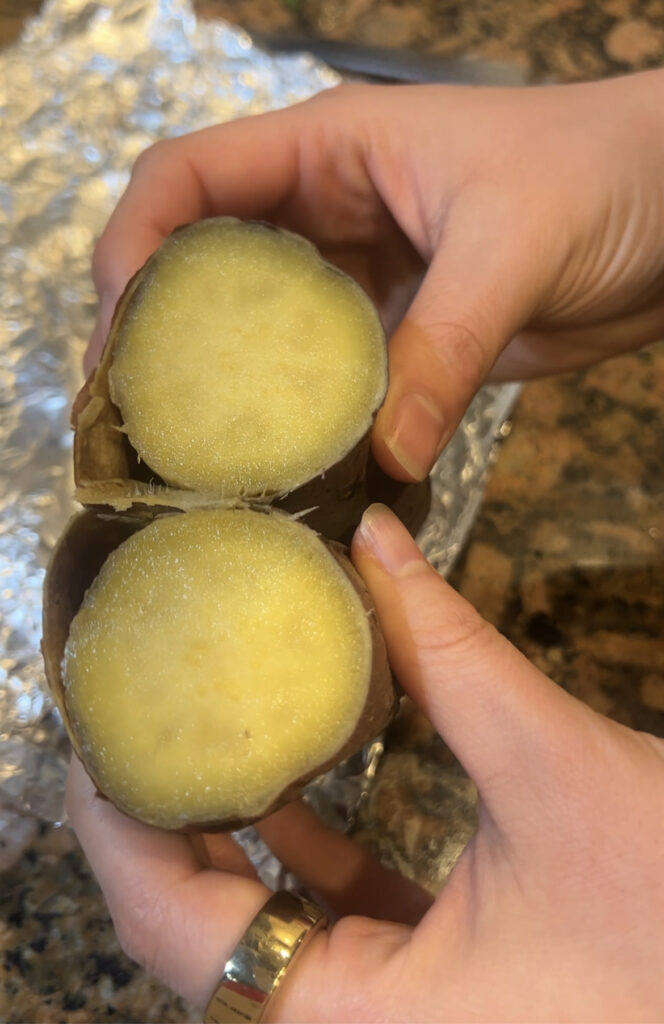
Did you know that cold Japanese sweet potatoes taste a bit different from freshly baked ones?
Chilled yakiimo have a custard-like texture, making them a unique, naturally sweet snack!
If you have leftovers, wrap them up and refrigerate overnight. The next day, enjoy a cold, silky-smooth yakiimo that tastes almost like sweet potato pudding!
If you try this Japanese yakiimo recipe, tag me @takahasheats on social media—I’d love to see your creations! 🍠💛
Now that you know how to make Japanese roasted sweet potatoes at home, you can enjoy the delicious taste of fall and winter in Japan anytime!
Itadakimas!
日本に住んでいる人なら、誰でも「焼き芋トラックの歌」を歌えるはず!
ゆっくり焼かれた日本のさつまいもの香ばしい香りと、流れる「いしや〜きいも〜♪」のメロディー。それが、日本の秋冬の風物詩!
寒くなってくると、日本のドン・キホーテに行くたびに、つい焼き芋を手に取ってしまいます(あの何でも売っている圧倒的な店舗の雰囲気、最高ですよね!)。 店の入り口には焼き芋のマシンが置かれていて、熱々の石の上でじっくり焼かれるさつまいもの香りが漂っているんです。それがもう、たまらなく美味しそう!
日本のスーパーや焼き芋トラックで売られている焼き芋の正式名称は「石焼き芋」。 「石」はその名の通り「石」のことで、伝統的に熱した石の上でじっくり焼くことからこう呼ばれます。 この「石焼き」の秘密は、さつまいもを65℃〜80℃の間でじっくり火を入れること。
なぜ焼くだけでこんなに甘くなるのか、その科学について少し説明します!
食べ物に含まれる酵素は本当に面白いです。実は、私は現在発酵食品の資格取得に向けて勉強していて、日本の食文化に関わる酵素についても学んでいます。 その中で「アミラーゼ」という酵素に出会いました。 アミラーゼはさつまいもに自然に含まれている酵素で、加熱することでデンプンを糖に変えてくれるんです。 だから、焼き芋はこんなにも甘くなるんですね!
さらに、加熱方法によって甘さのレベルが変わるんです。 先ほどお話しした65℃〜80℃の温度帯がアミラーゼの働きが最も活発になる温度なので、オーブンを予熱する際にさつまいもを入れるのがおすすめ!
こうすることで、最も簡単に焼き芋を作ることができます。 オーブンに入れるだけで、極上の甘さが引き出せるんです!
材料:
✔ 日本のさつまいも 2〜3本(紅はるかまたはシルクスイート)
✔ 水(ペーパータオルを浸すため)
✔ アルミホイル
※ さつまいもの品種やサイズによって食感が変わります。 私は「紅はるか」が一番クリーミーで好きですが、「シルクスイート」も美味しいです! 大きめのさつまいもなら、焼き時間は90分がおすすめです。
1. さつまいもをしっかり洗う(特に端の部分の汚れをブラシで落とす)。
2. 水気を拭かずにそのままキッチンペーパーで包み、さらに水で湿らせる。 ※ 水が滴るほどではなく、軽く絞る程度がベスト。
3. 湿らせたキッチンペーパーごと、アルミホイルでしっかり包む。
4. 天板にのせ、オーブンに入れる。
5. オーブンを160℃(320℉)に設定し、予熱と同時に加熱開始!
6. 予熱完了後、そのまま90分焼く。
7. 焼き上がったらオーブンの中で30分ほど放置し、じっくり冷ます。
8. 触れるまでに冷めたら食べれます!召し上がれ!
こうすることで、甘さと滑らかさが最大限に引き出されます。
熱々の焼き芋は、そのまま食べても最高! さらにバターやシナモンを加えると、より濃厚でリッチな味わいになります。
そして、ぜひ試してほしいのが「冷やし焼き芋」。 焼き芋を少し残してラップで包み、冷蔵庫で一晩寝かせると、しっとりなめらかでまるでスイーツのような味わいに!
もし作ったら、ぜひ @takahasheats でタグ付けしてシェアしてください! 皆さんの焼き芋がどうだったのか、ぜひ知りたいです!
